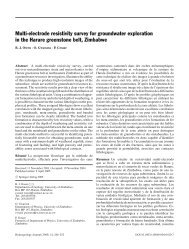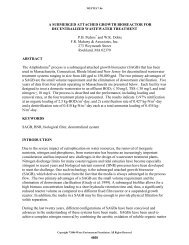Species diversity in the Florida Everglades, USA - Environmental ...
Species diversity in the Florida Everglades, USA - Environmental ...
Species diversity in the Florida Everglades, USA - Environmental ...
You also want an ePaper? Increase the reach of your titles
YUMPU automatically turns print PDFs into web optimized ePapers that Google loves.
Aquat. Sci. Vol. 68, 2006 Overview Article 255<br />
Figure 1. Major physiographic areas of south <strong>Florida</strong>, show<strong>in</strong>g<br />
wide, arch<strong>in</strong>g <strong>Everglades</strong> slough bounded on <strong>the</strong> east by <strong>the</strong> Atlantic<br />
Coastal Ridge and on <strong>the</strong> west by <strong>the</strong> Big Cypress Swamp. To <strong>the</strong><br />
north of <strong>the</strong> <strong>Everglades</strong> is Lake Okeechobee, <strong>the</strong> second largest <strong>in</strong>land<br />
freshwater lake <strong>in</strong> <strong>the</strong> <strong>USA</strong>. The <strong>Everglades</strong>’ watershed is more<br />
than twice its size extend<strong>in</strong>g more than 350 km from north to south<br />
(from McPherson and Halley, 1997).<br />
uses. Cumulative impacts over <strong>the</strong> last century have culm<strong>in</strong>ated<br />
<strong>in</strong> <strong>the</strong> system’s natural fl ow of water be<strong>in</strong>g controlled<br />
by 1,000 miles of manmade canals, 720 miles of<br />
levees, 16 pump stations and 200 gates that divert 6.4<br />
million m 3 of water daily from <strong>the</strong> <strong>Everglades</strong> to <strong>the</strong> surround<strong>in</strong>g<br />
seas. The biological consequences of hydrologic<br />
and water quality modifi cation have been dramatic:<br />
approximately 90–95 % of <strong>the</strong> wad<strong>in</strong>g bird population<br />
has been lost s<strong>in</strong>ce <strong>the</strong> 1930’s (Ogden, 1997) and major<br />
changes <strong>in</strong> ecosystem composition, structure and function<br />
have been widely documented (Davis and Ogden,<br />
1997; Forys and Allen, 2002).<br />
The <strong>Everglades</strong> National Park (ENP), established<br />
Dec. 6 th 1947 as <strong>the</strong> fi rst park <strong>in</strong> <strong>the</strong> national system selected<br />
primarily for biological attributes, lies with<strong>in</strong> <strong>the</strong><br />
larger <strong>Everglades</strong> system (Greater <strong>Everglades</strong>). In addition<br />
to its federal protection status, <strong>the</strong> park, which covers<br />
an area over 600,000 hectares at <strong>the</strong> extreme sou<strong>the</strong>rn<br />
tip of <strong>the</strong> <strong>Florida</strong> pen<strong>in</strong>sula, is recognized as a Natural<br />
World Heritage site and a Ramsar Convention site, and<br />
forms <strong>the</strong> heart of a group of protected areas <strong>in</strong> <strong>the</strong> South<br />
<strong>Florida</strong> ecosystem (<strong>in</strong>clud<strong>in</strong>g Big Cypress National Preserve,<br />
Biscayne Bay National Park, Dry Tortugas National<br />
Park, Key Largo National Mar<strong>in</strong>e Sanctuary, several<br />
National Wildlife Refuges and <strong>the</strong> <strong>Florida</strong> Keys<br />
National Mar<strong>in</strong>e Sanctuary).<br />
We beg<strong>in</strong> with an ecological characterization of <strong>the</strong><br />
<strong>Everglades</strong> and an overview of <strong>the</strong> historic and current<br />
system with a short discussion on <strong>the</strong> restoration efforts.<br />
Next, we present a literature review of bio<strong>diversity</strong> <strong>in</strong> <strong>the</strong><br />
<strong>Everglades</strong> and provide an extensive species list for<br />
plants and major animal groups. F<strong>in</strong>ally, we <strong>in</strong>troduce a<br />
systems approach to calculat<strong>in</strong>g bio<strong>diversity</strong> across<br />
trophic scales us<strong>in</strong>g one <strong>Everglades</strong> community as <strong>the</strong><br />
case study, end<strong>in</strong>g with a discussion on <strong>in</strong>tegrat<strong>in</strong>g<br />
trophic <strong>in</strong>teractions <strong>in</strong>to bio<strong>diversity</strong> calculations.<br />
Ecological characterization of <strong>the</strong> <strong>Everglades</strong><br />
The <strong>Florida</strong> pen<strong>in</strong>sula is <strong>the</strong> result of several alternat<strong>in</strong>g<br />
episodes of submergence and emergence <strong>in</strong> response to<br />
<strong>the</strong> rise and fall of sea level over <strong>the</strong> past 40 million<br />
years. At high sea level <strong>the</strong> plateau acted as a mar<strong>in</strong>e<br />
shelf and limestone was deposited. Dur<strong>in</strong>g times of low<br />
sea level, acidic freshwaters from decomposition of organic<br />
matter dissolved and eroded <strong>the</strong> limestone creat<strong>in</strong>g<br />
<strong>the</strong> riddled solution features that characterize <strong>the</strong> limestone<br />
underly<strong>in</strong>g <strong>the</strong> <strong>Everglades</strong> (Lane, 1994; Randazzo<br />
and Jones, 1997). Overlay<strong>in</strong>g <strong>the</strong> limestone <strong>in</strong> <strong>the</strong> central<br />
portions of <strong>the</strong> <strong>Everglades</strong> is a th<strong>in</strong> veneer of organic peat<br />
of vary<strong>in</strong>g depth, generally decreas<strong>in</strong>g from about 4–5 m<br />
<strong>in</strong> thickness <strong>in</strong> <strong>the</strong> nor<strong>the</strong>rnmost parts of <strong>the</strong> <strong>Everglades</strong>,<br />
south of Lake Okeechobee, to only several centimeters<br />
deep at its sou<strong>the</strong>rn extreme. The age of <strong>the</strong>se peats<br />
(about 5,000 years) suggests that only recently conditions<br />
have been favorable for <strong>the</strong> establishment of <strong>the</strong><br />
current vegetative communities (Gleason and Stone,<br />
1994). Soils <strong>in</strong> nearly half of <strong>the</strong> <strong>Everglades</strong>, along both<br />
<strong>the</strong> east and west marg<strong>in</strong>s, are characterized as calcitic<br />
muds that resulted from deposition from calcareous bluegreen<br />
algae periphyton associations <strong>in</strong> <strong>the</strong> alkal<strong>in</strong>e waters<br />
of <strong>the</strong> <strong>Everglades</strong> (Gleason, 1974).<br />
The climate of sou<strong>the</strong>rn <strong>Florida</strong> is described as subtropical<br />
and humid. Average temperatures range <strong>in</strong> <strong>the</strong><br />
mid 20s °C with lows <strong>in</strong> <strong>the</strong> w<strong>in</strong>ter averag<strong>in</strong>g 15 °C and<br />
highs <strong>in</strong> <strong>the</strong> summer averag<strong>in</strong>g about 27 °C. Average annual<br />
ra<strong>in</strong>fall over <strong>the</strong> <strong>Everglades</strong> is between 100 and<br />
165 cm (Duever et. al, 1994). The ra<strong>in</strong>fall pattern (Fig. 2)<br />
generally is characterized by a dry season that extends<br />
from November to April or May and a wet season from<br />
June to September or October (Fernald and Purdum,<br />
1998). The wet season usually accounts for more than<br />
half of yearly ra<strong>in</strong>fall and is dom<strong>in</strong>ated by convective<br />
systems, while storms <strong>in</strong> <strong>the</strong> w<strong>in</strong>ter months are usually
















